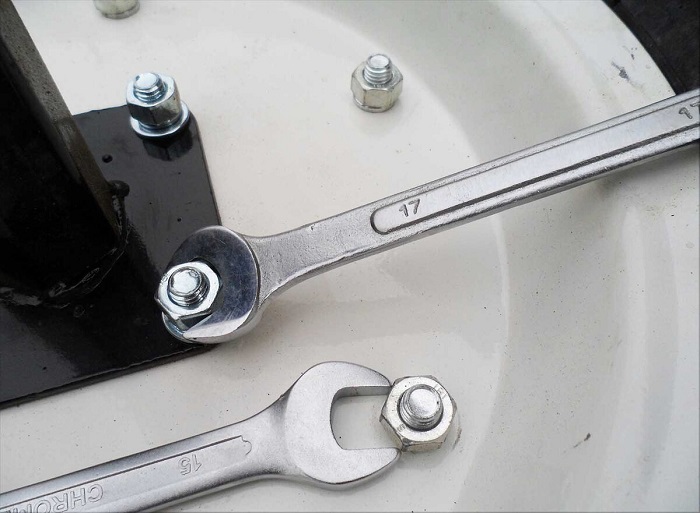
13 Oct The secret of secure connections: how to stop nuts and bolts from loosening
Every engineer, mechanic, or anyone who encounters the installation or repair of machinery is aware of the risk of unauthorised loosening of nuts and bolts. But why is this happening?
The technical side of the problem
- Vibration:
- Thermal Changes:
- The expansion and contraction of materials with temperature changes can affect the tightness of the joints.
- Improper Installation:
- If the bolt or nut has been tightened to the wrong torque, it may cause it to loosen.
- Thread wear:
- Constant loading and unscrewing can cause thread wear, which will reduce thread adhesion.
Coating features:
The coating of nuts and bolts can play an important role in preventing spontaneous loosening.
- Anti-corrosion coating:
- Protects against corrosion that can affect the tightness of the connection.
- Friction Coating:
- Special coatings can increase friction between threaded surfaces, reducing the risk of spontaneous unscrewing.
- Lubricants & Plastic Coatings:
- They help to facilitate installation, but can reduce the coefficient of friction, so their use requires caution.
Unauthorized unscrewing of nuts and bolts is the result of a number of technical factors, ranging from vibrations to thermal effects. Coating can help prevent this problem, but it’s important to understand its features and choose the right coating material based on your specific application.
Effect of Coating on Unscrewing Nuts and Bolts: No Coating vs. Zinc Coating
The coating for nuts and bolts is not only a protective layer against corrosion and other aggressive factors, but also affects the coefficient of friction between threaded connections, which directly affects the risk of spontaneous unscrewing.
Insufficient Coverage:
- Increased risk of corrosion: Without a protective coating, nuts and bolts are more susceptible to corrosion, especially in humid environments or when exposed to harsh chemicals.
- Change in the coefficient of friction: The presence of corrosion or other contaminants can increase friction between threaded surfaces, but can also lead to uneven tightening or damage to threads.
Zinc Coating:
- Corrosion Protection: The zinc coating acts as a protective anode, protecting the base metal from corrosive processes.
- Friction coefficient stability: Galvanizing can help provide a more stable coefficient of friction, which helps to tighten nuts and bolts evenly.
- Improved lubricant adhesion: Zinc coatings can improve adhesion between threaded surfaces and lubricants, reducing the risk of spontaneous loosening.
If we compare the absence of coating and zinc coating, it is obvious that the latter provides additional advantages in the form of corrosion protection and friction coefficient optimization. This makes galvanized nuts and bolts more reliable to use, especially in environments where there is a high risk of unscrewing from vibrations or other factors.
Anti-Loosening Tools
Various methods and materials are used to ensure the reliability of threaded connections and prevent their unauthorized unscrewing. Here are some fixed assets:
- Self-locking nuts:
- Specially designed to hold the threaded rod during vibrations or dynamic loads.
- Nuts with counter grips:
- They have special grips or protrusions that prevent them from being unscrewed.
- Gaskets & Washers:
- They are used to increase the contact area and distribute the pressure evenly, which prevents unscrewing.
- Filament retainers (anaerobic adhesives):
- Chemicals that ensure that threaded connections are securely fastened and prevent them from unscrewing spontaneously.
- Cotter pin and riveting:
- Physical fastening of elements that does not allow them to be unscrewed.
- Application of fixing foams or lubricants:
- An additional lubricating coating can reduce the risk of spontaneous loosening by reducing friction.
- Thread breakage:
- Once the nut or bolt is tightened, its end can be easily broken to form a “grip” that prevents loosening.
- Lock nuts:
- The application of two nuts on one bolt, where one nut is tightened to the other to prevent them from loosening.
The use of one or more of these products depends on the specific application, load level, operating conditions, and other factors. In practice, a combination of several methods is often used to ensure maximum reliability of threaded connections.
Conclusion
Unauthorized loosening of threaded connections, such as nuts and bolts, is a serious problem in many industries, from automotive to construction. This can lead to equipment loss, accidents, or other undesirable situations. To meet this challenge, there are a number of methods and tools designed specifically to ensure the reliability of threaded connections.
From physical fixtures such as cotter pins or locking nuts to chemical methods such as anaerobic adhesives, these products provide an extra layer of protection against unauthorized unscrewing. It is especially important to correctly select and combine these methods depending on the specific situation, conditions and type of load.
In addition, we must not forget about the correct installation and maintenance of threaded connections. Regular inspection, inspection, and replacement of damaged parts are key aspects of ensuring their durability and reliability.
Ultimately, ensuring the reliability of threaded connections requires a combination of the right choice of materials, the use of appropriate technical solutions and regular maintenance.




No Comments